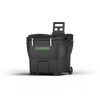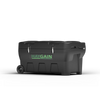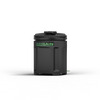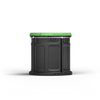21/10/2019
The Ammonia smell in the stable: Is it a health threat? Or an innocent, if unpleasant, part of life with horses?
Written by Karen E. N. Hayes, DVM, MS
If a friend blindfolded you and dared you to sniff an open bottle which unbeknownst to you, contained household ammonia, one whiff and you’d instantly recoil, almost as though you’d just touched a hot stove. It’s a normal reflex. In a horse stable, that same pungent odor tends to evoke a milder reaction, even if the smell is just as strong. And, the longer we’re in the stable, the less we notice the ammonia.
In fact, for a lot of horse owners (myself included), that smell is almost pleasant. It actually beckons us in. Does our response to ammonia fumes depend on the nose of the beholder?
In a way, yes. When sniffed without fair warning, ammonia fumes naturally evoke a startle-type reflex. That’s the physiological effect of noxious gases, including ammonia, on receptors attached to our eyes and respiratory passages: It triggers an alarm from a region of the brain called the amygdala. Among other duties, the amygdala protects us by instantly making us pull away from things that our physiology registers as potentially harmful.
Why is the reaction milder when the ammonia is in an equestrian environment? Two reasons. First, we aren’t surprised by the smell, so there is forewarning. And second, there’s an emotional element involved in that particular context, associated with positive feelings about horses, horse people, horse activities… and how being in that environment softens the stresses and challenges of our “other” lives.
Why do those ammonia fumes become even less objectionable the longer we’re inside the stable? That’s a phenomenon called olfactory fatigue. The smell-sensing (olfactory) system actually tires of sounding the alarm. It’s not unlike what happens when you draw a bath that’s too hot for comfort: Stick a toe in: The water feels scalding. But within a few minutes of dipping toes, then ankles, etc., you’re able to lower yourself in and find the temperature tolerable. The water hasn’t cooled much at all. Your nerve endings have fatigued.
So, are ammonia fumes in the stable a significant health issue, for us and for our horses? Or is it a matter of context, and acclimation? Let’s take a closer look at the gas itself, then explore the ways it colors life around horses.
What is ammonia?
AEGL-1
Ammonia (NH3) is a caustic gas. Caustic means strongly alkaline (the opposite of strongly acidic). Lye is another example of a caustic substance.
Ammonia is well recognized, in scientific and government institutions and publications, as sufficiently alkaline to be a “strong irritant,” even in small doses and at relatively low concentrations. Most often, ammonia irritates vulnerable tissues such as skin, eyes, nasal passages, sinuses, the respiratory tree and the lungs. The effect can range from short-lived reversible discomfort, to serious health effects that are chronic, irreversible, and sometimes even life-threatening.
If you’re thinking this is an issue that’s hazardous only for workers in jobs involving industrial exposure to ammonia, you’re wrong, but you’re in good company. What makes the health risks even more serious is the fact that because of emotional context and olfactory fatigue, our self-protective response to ammonia exposure in the stable is impaired. If we’re better informed about this noxious gas, we can stop underestimating not only its inherent dangers, but also the impact we can have on significantly reducing ammonia in the stable.
How much ammonia is too much? The standard reference that sets the safety limits for exposure to noxious gases, including ammonia, is the Acute Exposure Guideline Level, or AEGL. There are three AEGL levels of exposure, each divided into five exposure periods: 10 min, 30 min, one hour, four hours, and eight hours. The stronger the ammonia, the shorter the exposure time that can cause irreversible injury.
The table below shows Summary of Acute Exposure Guideline Level Values for Ammonia
***For reference, if the human nose can detect ammonia fumes, then the concentration of ammonia in the air is at least 5 ppm (parts per million).
To set the stage for you, I measured ammonia levels over a six-year period during my tenure as stud farm veterinarian at high-end facilities. All stalls were cleaned at least once daily. Some barns had huge fans beneath the ridgeline of the roof, designed to pull stale air upward and out while pulling fresh air in through the double doors at the ends of each aisle.
Some barns lacked whole-barn ventilation systems but had box fans bungee-corded to the bars of the stall fronts, some aiming directly across to the back wall of the stall, some facing the aisle, ostensibly pulling air out from the stall.
Some barns had both whole-barn ventilation and individual stall fans. All stalls had solid fronts from ground level to four or five feet up; the upper portion was open, with or without bars. Some stalls had attached walk-in runs, some did not. Some had windows on the back wall; others did not.
The results are as follows:
In all facilities, ammonia levels inside the stalls ranged from 80 to 450 ppm (parts per million) when measured within 12 inches of the stall floor. Neither the whole-barn ventilation fans, nor the box fans attached to the stall fronts, had a significant effect on ammonia levels in that low-down 12-inch zone.
At five feet up from the ground (roughly in range of the average human nose), ammonia levels in the stalls varied from 10 to 50 ppm within ten minutes of turning off the box fans (if the stalls were so equipped). In the aisles of the barns, ammonia levels were 0 when ridgeline fans were running, and up to 15 ppm when ridgeline fans were turned off. Individual stall box fans had no significant effect on ammonia levels in the aisles or inside the stalls at floor level.
In summary: Up to 450 ppm at floor level in the stalls, affecting mostly the horses; 10 to 50 ppm at nose level in the stalls, affecting mostly the horses; and 0 to 15 ppm in the aisles, affecting mostly the humans. Let’s see where those figures sit in the AEGL system.
AEGL-1 is considered the mildest level of ammonia exposure, at 30 ppm or less, and is generally considered “non-disabling” even at eight hours of exposure, expected to cause no more than mild and temporary irritation of the eyes, nose and/or throat . It’s also considered non-disabling even if you and/or your horse already have other relevant health issues such as dry eye, eye irritation, eye injury or infection, respiratory or skin allergies, asthma, bronchitis, heaves, or airway hypersensitivity. So, the measurements taken in the high-end stables were consistently well below AEGL-1 only in the aisles.
***Based on data from the workplace, the US Occupational Safety and Health Administration (OSHA) dictates that employers cannot allow workers to be exposed to more than a total of two hours’ exposure to 50 ppm (parts per million) ammonia fumes in any 24-hour period. In one study, after only 10 minutes’ exposure to 50 ppm, human volunteers described the fumes as deeply penetrating, and experienced moderate eye, nose, throat, and chest irritation. At 80 ppm for 30 minutes to two hours, the irritation was described as moderately to highly intense. At 110 ppm for 30 minutes to two hours, it was highly intense. At 140 ppm for 30 minutes to two hours, it was “unbearable.” At 500 ppm for 30 minutes, most subjects had tears running from their eyes.
AEGL-2
AEGL-2 exposure to ammonia is 220 ppm for 10 to 30 minutes, 160 ppm for one hour, or 110 ppm for four to eight hours. Human volunteers found the irritation of their eyes and throat at 110 ppm to be “offensive,” and many left the chamber at the higher levels of exposure. You, and your horse, exposed to ammonia fumes at these levels, can experience significant irritation of eyes and throat, and an increased urge to cough. You, and your horse, also are at risk for the health consequences of exposure to be irreversible, including the possibility that athletic ability and exercise tolerance will decline. If you, or your horse, have a pre-existing condition (including such things as dry eye, eye irritation, eye injury, eye infection, respiratory or skin allergies, asthma, bronchitis, heaves, or airway hypersensitivity), you can expect this level of exposure to make the condition you already have, worse.
AEGL-3
AEGL-3 ammonia exposure is considered potentially lethal. It ranges from a high of 2,700 ppm for 10 minutes (which is associated with working in industrial chemical facilities and exposure to accidental chemical spills), to a low of 390 ppm for eight hours (which is very possible in a horse stall). Remember, at floor level in many of the stalls in my veterinary rounds, measurements of ammonia levels were at 450 ppm. And, many horses spend far longer than eight hours in their stall in any 24-hour period, meaning they easily meet the criteria for AEGL-3 conditions and are at real risk. It’s worth pointing out that this level of exposure in a stable is not necessarily a take-five-steps-and-die kind of lethality.
It’s more likely to cause health effects that can destroy an athlete’s future, cause a trail horse to cough at the slightest exertion and need rest stops to catch his breath, impair even a retired horse’s quality of life, and lead many owners to consider having their horse euthanized for humane and/or practical reasons (the horse no longer serves their purposes). That’s the kind of lethality that applies most typically in the horse stall: less dramatic than what can happen in chemical spills, but heart wrenching and tragic nonetheless, particularly since it can be prevented (more on that in a moment).
A horse’s age is also possibly a factor. In studies with human volunteers, high AEGL-2 and low AEGL-3 exposure levels triggered a protective closing of the throat —a choking-down reflex that compelled the participants to stop the trial. In aged volunteers, however, that protective reflex was as much as three times slower to happen, compared to younger volunteers. If this protective reflex is similarly handicapped in aged horses, it means that even if our senior horses have the freedom to leave the stable and get some fresh air, they’re less likely to feel physically compelled to do so. Instead, they might stay in that toxic environment, inhaling that toxic air, incurring further damage with every breath.
What you need to know about ammonia in the stable
- Ammonia levels in the stable are higher, and a more serious health risk for ourselves and our horses, than most people think .
- Most assessments of air quality in stables are made subjectively, by olfactory-fatigued noses of humans, standing upright in the stalls and in the aisles. Assessments are rarely done objectively, with instruments designed to measure ammonia, not only at standing human nose level but in all relevant areas of the barn, especially at floor level in the stalls.
- Much of the air a stabled horse draws into his lungs is within that low-down floor-level range where ammonia levels are highest -when he’s standing and nibbling at feed that was placed on, or has fallen to, the floor, and when he’s lying down and sleeping (when he’s breathing most deeply, really pulling those fumes in). Because foals sleep so much, a foal in that stall would breathe high levels of ammonia many times more than fresher air.
The underlying problem
To get at the source of the fumes, we need to understand where the ammonia in the stable comes from. It’s not, technically, from urine.
Ammonia is not a normal component of urine. Urine contains urea, which is a byproduct of the digestion and metabolism of protein in the horse’s diet. But urea is odorless.
So where does the ammonia come from?
From the breakdown of urea, which is done by various bacteria that happen to love urea as a food source. If it’s available to them, they’ll flourish on it. They’re equipped with an enzyme called urease which digests the urea and produces ammonia as a by-product. But healthy urine is sterile. It doesn’t have bacteria in it.
So where do those urea-digesting, ammonia-belching bacteria come from?
They’re abundant in many substrates on the ground. If urea is regularly available to them, their originally small population there will explode, and the level of ammonia in the stable will intensify exponentially with every new “delivery” of urea-rich food (your horse’s urine). The situation quickly escalates to the point at which stripping the stall and leaving it empty for a few days to dry does nothing to dampen the ammonia smell. There’s so much stockpiled urine already soaked deeply into the substrate that the bacteria can live on its urea for a long time, while the ammonia continues to stream up and into the stall.
So let me ask you some questions about your horse’s stall....
What kind of bedding do you use?
Is it hay, straw, coir, shredded paper, wood shavings, sawdust, peanut hulls, compost...?
What’s under the bedding?
Is it soil, clay, sand, gravel, porous concrete, rubber mats….?
Do you know what’s the typical volume of urine a horse expels with a single urination? (Depending on your horse, it can be as little as half a gallon or more than a gallon.)
How many times does your horse urinate in the stall in a 24-hour period? (How many wet spots are there in the bedding?) Add it up. How much urine, total, per 24 hours? Is there any stall bedding that can absorb even half a gallon of urine when it gushes out of your horse all at once, all in one place? I have yet to meet such bedding.
So… when you remove the wet bedding, have you removed all the urine? Or did much of it spill through? Is the floor beneath the bedding porous, even a little? If you have stall mats, could the urine sneak into the gaps between them, and soak into whatever is underneath them?
Do you see the problem?
When urine soaks into the floor beneath the stall bedding, whether that floor is soil, sand, gravel, porous concrete, etc., or the nooks and crannies between the rubber mats laid on top of those substrates, it encounters bacteria. Many of the bacterial species there are urease-equipped, ready and waiting for a load of urea-rich urine to fuel their next population explosion and the ammonia exhaust it inevitably produces. For those bacteria, the mother lode is the urine that got away from the bedding. And because of the volume of urine a horse produces, there is no such thing as a bedding material that can catch it all. In fact, most of the urine runs right through even the most absorbent bedding, into whatever is beneath it. Bedding is important for comfort, and cushion, and hoof support, and to prevent slipping, but it’s ill equipped to catch and hold all but just a fraction of the urine your horse produces.
A major key to controlling the levels of ammonia in a stable is understanding the fact that microbial action creates ammonia fumes.
Addressing ammonia at its source In the construction of stables, the tradition is to provide “good drainage” in the stalls. Now, we know better. Good drainage is important to keep the barn from flooding in heavy rains, but for the stalls themselves, it’s important to stem the tide of ammonia fumes by making the floor non-porous. That way, you can contain the urine. This gives the bedding more chances to absorb it, so that when you muck out the wet bedding you can remove all the urine and starve subterranean populations of bacteria that have been thriving on its steady supply of urea.
The AEGL system of categorizing the health risks of ammonia exposure shows that potentially fatal exposure (including euthanasia because of permanent loss of athletic performance) is possible within even high-end horse facilities, where 450 ppm ammonia fumes have been measured at floor level. Wall-to-wall, seam- and perimeter-sealed, non-porous flooring, properly installed, blocks the continuous microbial production of ammonia from urine soaking into the stall’s sub-floor. Such flooring carries the additional benefits that it can be swept, raked, mopped, swabbed, scrubbed, and disinfected. This can dramatically reduce the potential harboring of infectious disease-causing microbes in the nooks and crannies that are typical of the traditional stall floor, reducing the risk of facility-wide outbreaks of such diseases as Salmonellosis and equine strangles. Because ammonia fumes are a major fly attractant, reducing ammonia production on the facility can reduce fly pest populations on the facility. In short, please don’t underestimate the potential health risks of ammonia exposure. What’s underneath the bedding in your horse’s stall may be out of sight, but keep it on your mind, because it is an important way to make real, measurable improvement in the quality of air he breathes if he spends even part of his days in a stall. The right floor can be the key to a healthier and more comfortable horse, and a healthier and happier you.
StableComfort and ComfortStall still look great, despite years of supporting warmbloods and draft horses with shoes.
They’ve expertly contained untold oceans of urine, birth fluids and more, for easy cleanout and disinfection.
ComfortStall, which had been #3 in my original head-to-head comparison, is now my #1 because of its turf-like softness which appears to provide the best hoof support, and because of its smooth, ripple-free surface which allows a flat shovel to scrape up smashed and dried manure without catching.
Earlier, I had been concerned that ComfortStall’s topcoat would suffer from wear and tear, but even today, after a thorough cleaning, it still looks new. I love both of these floors. With all three systems, ammonia fumes reduced to the low end of AEGL-1 (specifically, 0 to 15 ppm) within a couple months of installing them over previously porous floors. For all three floors, installation required some basic construction skills (such as knowing how to level a floor, deal with a stall that might not be well squared, and how to work with epoxies and in some cases drilling into masonry).
Major muscle power was needed to install the Lap-N-Lock panels, which were crazy heavy. It took two days for two young, strong men to grunt and epoxy them into place in one 20 x 20 foot stall.
ComfortStall was feather-light, with a foam under-mat beneath a geotextile over-coat. It was a breeze to install. This is one reason I’m surprised by how well it has held up to use. When my book came out in 2005, a competitor referred to ComfortStall, derisively, as “pony mats,” but ComfortStall has earned my gold star for, among its many other great qualities, holding up to over a decade of heavy use by heavy horses wearing heavy shoes.
StableComfort’s rubber-filled under-mats were heavy but not terribly so, and once they were arranged, attaching the top geotextile coat was easy. This floor, too, has held up well, but it does have some ripples that are a mild impediment to scraping up sticky smashed manure. Not a big deal, but worth mentioning.
For both StableComfort and ComfortStall, the results are, in my opinion, well worth any added expense of hiring a contractor to do the installation.
***Additional benefits of non-porous floors is the ability to thoroughly swab, scrub, and disinfect them, thereby reducing the nooks and crannies in a stall where nasty pathogens can hide, such as Salmonella and Streptococcus equi (the cause of equine strangles).
The bottom line
The highest levels of ammonia fumes measured in well-heeled horse facilities in my study were found inside individual occupied stalls, within 12 inches of the stall floor. Because most facilities’ ammonia problems are gauged subjectively, by human noses at standing level, the ammonia problem afflicting horses’ health is largely underestimated, if not overlooked.
The AEGL system of categorizing the health risks of ammonia exposure shows that potentially fatal exposure (including euthanasia because of permanent loss of athletic performance) is possible within even high-end horse facilities, where 450 ppm ammonia fumes have been measured at floor level. Wall-to-wall, seam- and perimeter-sealed, non-porous flooring, properly installed, blocks the continuous microbial production of ammonia from urine soaking into the stall’s sub-floor. Such flooring carries the additional benefits that it can be swept, raked, mopped, swabbed, scrubbed, and disinfected.
This can dramatically reduce the potential harboring of infectious disease-causing microbes in the nooks and crannies that are typical of the traditional stall floor, reducing the risk of facility-wide outbreaks of such diseases as Salmonellosis and equine strangles. Because ammonia fumes are a major fly attractant, reducing ammonia production on the facility can reduce fly pest populations on the facility. In short, please don’t underestimate the potential health risks of ammonia exposure. What’s underneath the bedding in your horse’s stall may be out of sight, but keep it on your mind, because it is an important way to make real, measurable improvement in the quality of air he breathes if he spends even part of his days in a stall. The right floor can be the key to a healthier and more comfortable horse, and a healthier and happier you.
References
Acute Exposure Guideline Levels for Selected Airborne Chemicals: Volume 6.
National Research Council (US) Committee on Acute Exposure Guideline Levels.
Washington (DC): National Academies Press (US); 2008.
Brautbar N, Wu MP et al. Arch Environ Health. 2003 Sep;58(9):592-6. Chronic ammonia inhalation and interstitial pulmonary fibrosis.
Equine Vet J. 1987 Nov;19(6):524-30. The relationship of air hygiene in stables to lower airway disease and phyaryngeal lymphoid hyperplasia in two groups of Thoroughbred horses.
Gosselin R, Smit R et al. Clinical Toxicology of Commercial Products. 5th Ed.. Baltimore: Williams and Wilkins, 1984., p. 111-122
Hayes K.E.N. How To Be The Perfect Horsekeeper. Hayden Lake, ID: Ironhorse Publishing 2005; 25-8; 131-172.
HHS/ATSDR; Toxicological Profile for Ammonia p.16 (September 2004) TP 126. Agency for Toxic Substances & Disease Registry.
Prager J.C. Environmental Contaminant Reference Databook Vol 1. New York, NY: Van Nostrand Reinhold 1995., p 137.
Saito N, Yamano E et al. Involvement of the olfactory system in the induction of anti-fatigue effects by odorants. PLoS One. 2018 Mar 29;13(3):e0195263
TRENDING ARTICLES
-
BEFORE YOU GO
Get the Haygain Newsletter
Subscribe for the latest news, health advice, special offers and competitions. Fill out the form at the bottom of this page.




















